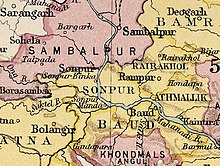Athmallik State (Odia: ଆଠମଲ୍ଲିକ) was a princely states of India during the period of the British Raj. The state was a former jagir recognized as a state in 1874 and had its capital in Kaintaragarh near the town of Athmallik.[1] located in the present-day Angul district of Odisha. It had an area of 1,890 square kilometres (730 sq mi) and a population of 64,276 and with an average annual revenue of Rs.2,17,000 at the 1947-48 time period.
| State of Athmallik ଆଠମଲ୍ଲିକ ରାଜ୍ୟ | |||||||
|---|---|---|---|---|---|---|---|
| Princely State of British India | |||||||
| 1785–1948 | |||||||
 Athmallik State in the Imperial Gazetteer of India | |||||||
| Capital | Kaintaragarh | ||||||
| Demonym | Athmallikia | ||||||
| Area | |||||||
• | 1,890 km2 (730 sq mi) | ||||||
| Population | |||||||
• | 64,276 | ||||||
| Historical era | 11th century | ||||||
• Established | 1785 | ||||||
| 1948 | |||||||
| |||||||
| Today part of | Angul District, Odisha | ||||||

History
editAthmallik was initially an estate (jagir) which was recognized as a princely state in 1874. Athmallik was one of the 26 feudatory states of Odisha. Kaintaragarh was the capital of Athmallik State, being carved out of the erstwhile Baudh ex-feudatory state.
In the 11th century, it became a separate princely state, established by King Pratap Deo, a scion of the Kadamba Dynasty. Pratap Deo was said to have found a Honda (Metal Vessel) which was considered to be lucky enough, after which the territory was then named as "Hondapa".
In the course of time, one of the chiefs divided the ex-state into eight divisions and placed one sub-chief called "Malla" in each division with a view of suppressing the unruly tribes; on this basis the kingdom changed its name from "Hondapa" to "Athmallik".
On 1 January 1948 the last ruler of Athmallik signed the accession to the Indian Union after independence and following which it merged with the state of Odisha forming a part of the Dhenkanal District. In 1 April 1999, the Dhenkanal District was divided to create the Angul District, and Athmallik became a sub-division of Angul.
Rulers
editRulers of the State of Athmallik are as follows:.[2]
- Jogendra Samant (1874 - 1877)
- Mahendra Deo Samant (4 Feb 1877 - 190.)
- Bibhendra Deo Samant (190.- 3 Nov 1918)
- Kishore Chandra Deo Samant (b. 1904) (3 Nov 1918 – 1 Jan 1948)
Titular
edit- Raja Surajmani Deo Samant (b. 1995)
See also
editReferences
editExternal links
edit- Athmallik State – Pictures of the Palace Archived 24 May 2018 at the Wayback Machine